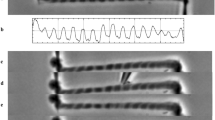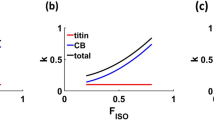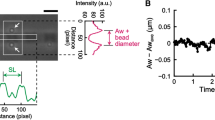Abstract
A report1 in 1977 raised the intriguing possibility that sarcomere shortening in muscle may occur in a stepwise fashion, in which episodes of shortening are interrupted by periods of little or no movement. This was taken by its authors to imply the synchronous activity of cross-bridges over a large volume of tissue—behaviour which cannot easily be reconciled with commonly accepted views of muscle contraction2–5. Stepwise shortening has also been reported recently in relaxed muscle fibres on which length changes were externally imposed4,6,7, and that system has allowed us to define more rigorously the circumstances in which stepwise shortening is observed. Here we report a high correlation between the frequency of ‘steps’ or ‘pauses’ and the translation velocity of the fibre past the measuring system, suggesting that stepwise shortening is not a physiological property of muscle but an instrumentation artefact.
This is a preview of subscription content, access via your institution
Access options
Subscribe to this journal
Receive 51 print issues and online access
$199.00 per year
only $3.90 per issue
Buy this article
- Purchase on Springer Link
- Instant access to full article PDF
Prices may be subject to local taxes which are calculated during checkout
Similar content being viewed by others
References
Pollack, G. H., Iwazumi, T., ter Keurs, H. E. D. J. & Shibata, E. F. Nature 268, 757–759 (1977).
Rüdel, R. & Zite-Ferenczy, F. Nature 278, 573–575 (1979).
Pollack, G. H., Vassallo, D. V., Jacobson, R. C., Iwazumi, T. & Delay, M. J. in Cross-bridge Mechanism in Muscle Contraction (eds Sugi, H. & Pollack, G. H.) 23–40 (University of Tokyo Press, 1979).
Pollack, G. H. et al. in Contractile Mechanisms in Muscle (eds Pollack, G. H. & Sugi, H.) (Plenum, New York, in the press).
Delay, M. J., Ishide, N., Jacobson, R. C., Pollack, G. H. & Tirosh, R. Science 213, 1523–1525 (1981).
Lacktis, J. W., Brozovich, F. V. & Pollack, G. H. Biophys. J. 37, 358a (1982).
Lacktis, J. W., Brozovich, F. V. & Pollack, G. H. Biophys. J. 41, 264a (1983).
Iwazumi, T. & Pollack, G. H. I.E.E.E. Trans. Biomed. Eng. 26, 86–93 (1979).
Myers, J., Tirosh, R., Jacobson, R. C. & Pollack, G. H. IEEE Trans. biomed. Engng 29, 463–466 (1982).
Jacobson, R. C., Tirosh, R., Delay, M. J. & Pollack, G. H. Biophys. J. 33, 223a (1981).
Vassallo, D. V. & Pollack, G. H. Circulation Res. 51, 37–42 (1982).
Rüdel, R. & Zite-Ferenczy, F. J. Physiol., Lond. 290, 317–330 (1979).
Oba, T., Baskin, R. J. & Lieber, R. L. J. Muscle Res. Cell Motility 2, 215–218 (1981).
Yeh, Y., Baskin, R. J., Lieber, R. L. & Roos, K. P. Biophys. J. 29, 519–522 (1980).
Jacobson, R. C., Tirosh, R., Delay, M. J. & Pollack, G. H. J. Muscle Res. Cell Motility (in the press).
Author information
Authors and Affiliations
Rights and permissions
About this article
Cite this article
Altringham, J., Bottinelli, R. & Lacktis, J. Is stepwise sarcomere shortening an artefact?. Nature 307, 653–655 (1984). https://doi.org/10.1038/307653a0
Received:
Accepted:
Issue Date:
DOI: https://doi.org/10.1038/307653a0
This article is cited by
-
Sarcomere length behaviour along single frog muscle fibres at different lengths during isometric tetani
Journal of Muscle Research and Cell Motility (1989)
-
Stepwise shortening of muscle fibre segments
Journal of Muscle Research and Cell Motility (1987)
-
Correlation between the light diffraction pattern and the structure of a muscle fibre realized with Ewald's construction
Journal of Muscle Research and Cell Motility (1986)
-
The descending limb of the sarcomere length-force relation in single muscle fibres of the frog
Journal of Muscle Research and Cell Motility (1985)
-
Tension responses to rapid length changes in skinned muscle fibres of the frog
Pfl�gers Archiv European Journal of Physiology (1985)
Comments
By submitting a comment you agree to abide by our Terms and Community Guidelines. If you find something abusive or that does not comply with our terms or guidelines please flag it as inappropriate.



